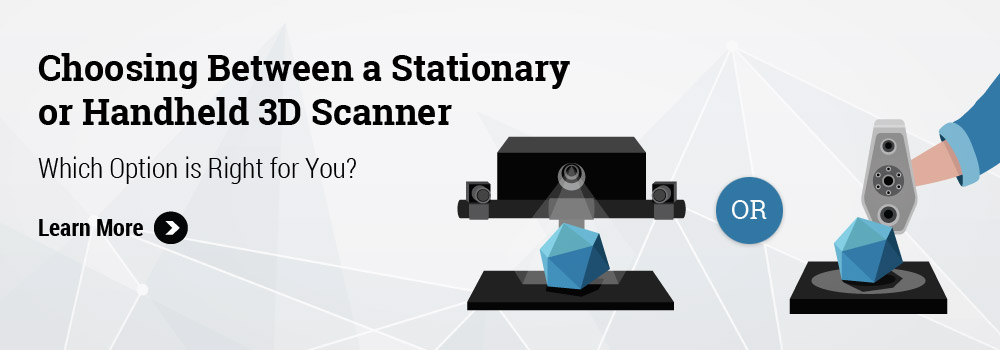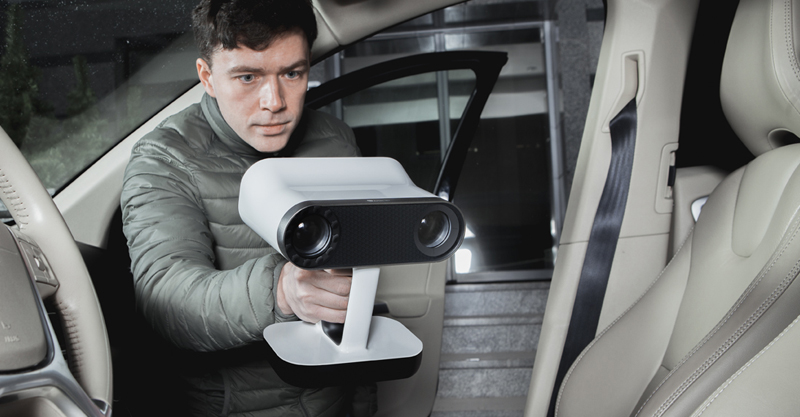
Artec Leo just came out this month and there’s a lot of buzz and excitement surrounding its launch. Professional 3D scanning systems are often more difficult to learn and operate than its consumer grade counterpart. What’s remarkable about the new Leo is that it’s a professional grade 3D scanner that truly encapsulates an intuitive mobile scanning experience while attaining high resolution 3D models with great accuracy.
To look at it another way–it’s like getting the Apple experience for 3D scanning.
As Artyom Yukhin, Artec CEO and president, sums it up best, “Our goal is to make professional 3D scanning as easy as shooting video for any industry and Artec Leo is the next big step in achieving that goal.”
So what’s special about the Artec Leo? Let’s look at how it takes 3D scanning to a new level.
First Scanner to Offer Onboard Automatic Processing
Typically, a 3D scanner consists of a scan head and requires a separate computer that acts as the 3D scanning engine for data acquisition and post-processing. What makes Artec Leo unique is that it features its own internal computer (NVIDIA Jetson processor) embedded right inside the scanner.
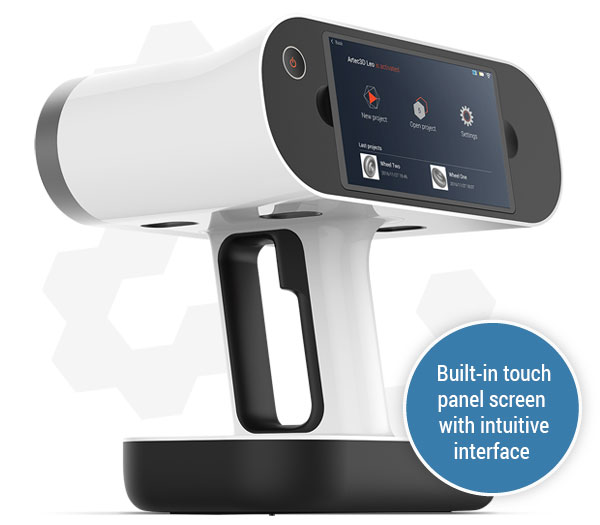
Multi-core processing:
- NVIDIA® Jetson™ TX1
- Quad-core ARM® Cortex®-A57 MPCore Processor
- NVIDIA Maxwell™ 1 TFLOPS GPU with 256 NVIDIA® CUDA® Cores
Artec Leo can instantly project 3D models to its built-in 5.5″ multi-touch HD screen to process large volumes of 3D data onboard. As you scan an object, you can see the 3D reproduction of the physical object being built in real-time on Leo’s touch panel screen. Rotate the 3D model, check if you have captured all areas, and fill in any parts you may have missed.
There’s no need to connect the scanner to a tablet or computer. It does provide users the option to connect wirelessly to a second screen for a larger display or for collaborative work for added flexibility.
True Mobile Experience
Thanks to its powerful embedded processor and the inbuilt battery, Artec Leo gives new meaning to the term mobile 3D scanning. There’s no need to connect to a computer or plug into a main power source. You can hold Leo in one hand and walk around freely, scanning your object without tripping on any wires or the need to connect to additional equipment.

Artec Leo enables 3D scanning on expeditions or in remote areas with no power supply. You can also purchase supplementary battery modules for unlimited 3D scanning.
One of the things you might be wondering is how does this scanner store scan data? 3D scanning tends to create large file size, which is especially challenging for off-site excursions. Artec Leo has a built-in SSD drive to store 256 GB of captured data with the possibility of expanded memory with micro SD cards. Once scans are completed, you can upload the scan data to a computer via Wi-Fi or Ethernet connection, or directly to the cloud.
Fastest Professional Handheld 3D Scanner on the Market
Artec Leo is the fastest professional handheld 3D scanner on the market with 80 frames per second 3D reconstruction rate.
Let’s compare the Leo with other Artec 3D scanner models:
| Artec Leo | Artec Eva | Artec Space Spider |
|---|---|---|
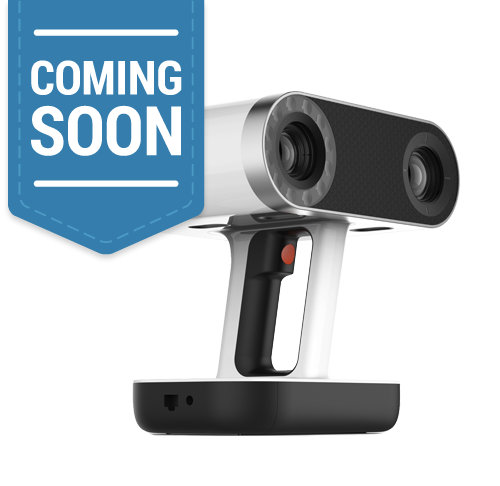 |
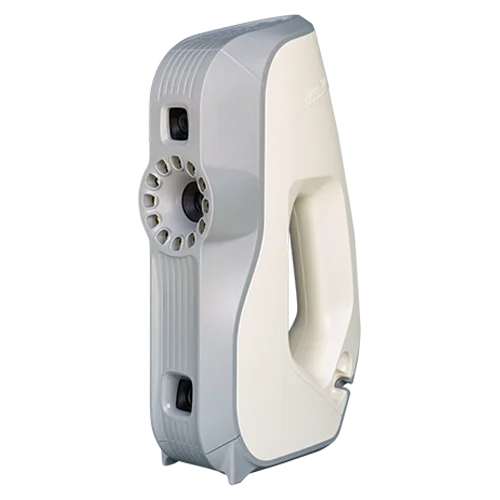 |
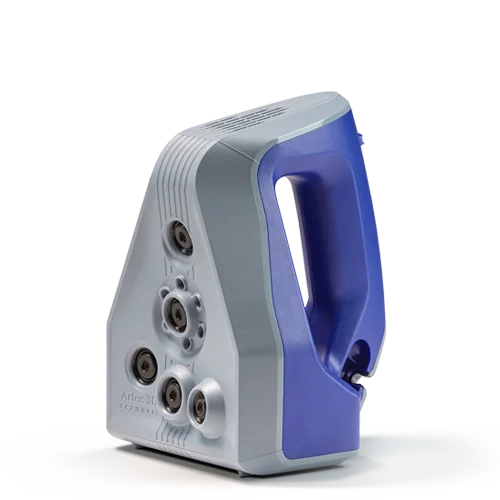 |
|
80 frames per second |
16 frames per second |
7.5 frames per second |
Looking at the specifications, Artec Leo is 5x than the Artec Eva and 10x faster than the Artec Spider in terms how many frames it can capture per second. Artec has taken a big leap in this development.
With a large, professional grade lens system, Artec Leo also has a bigger field of view (scanning volume of 173,000 cm³) compared to other Artec models. Combined this with a fast reconstruction rate, the scanner can capture large objects and scenes in minimal time.
Other Advancements

Built-in 9 Degrees of Freedom (DoF) Inertial System
Artec Leo is the only handheld 3D scanner to be able to precisely pinpoint its position within its surroundings with an internal accelerometer, gyro, and compass system. The scanner can differentiate between horizontal and vertical surfaces (such as floors and walls) to automatically erase unwanted background data to save you valuable time.
Tackle conventional 3D scanning challenges
3D scanners that use light as a projection source often have difficulties scanning:
- dark surfaces because black surfaces absorb light
- translucent or reflective surfaces because light is reflected while scanning
Artec Leo overcomes these challenges with the addition of 3D HDR. It makes it easier to scan black and shiny objects, normally tricky for other 3D scanners to capture. Artec Leo also employs disruptive VCSEL light technology, which helps tremendously in scanning hard to scan textures (including skin) and can scan well even in bright light conditions, even outdoors, which is proven difficult to do using other light-based projection 3D scanners (such as structured or laser).
Enhanced color capture
Capturing color texture of an object helps to capture its true likeness in 3D digital form. Artec Leo has a two-in-one optical system with the 3D camera and color camera combined and directed through the same lens. This advanced proprietary system provides the most exact texture to geometry mapping at an impressive resolution of 2.3 megapixels.
Availability
Artec announced the launch of the Leo on March 8 and it will become available for purchase later this year. For more information, please download the brochure or visit the product page.
The Artec Leo is a powerhouse handheld 3D scanner that pushes the boundaries of visual and AI computing. It makes real-time 3D capture, modeling and visualization a reality all within a single handheld device. We’ll continue to provide updates on the Artec Leo including sample data and videos as soon as they become available.
